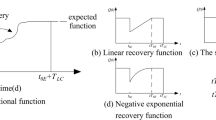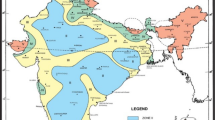Abstract
The deterioration of the performance of offshore bridges is particularly prominent due to the complex natural environment, including the coupling effects of earthquake and seawater erosion. In particular, bridge piers are the main energy-consuming and load-bearing components, so that excellent seismic capacity of bridge piers is the key to avoiding bridge damage. Although earthquake resistant behavior of ordinary reinforced concrete bridge piers (ordinary pier) can be improved by increasing the section size and reinforcement ratio of piers, the improvement of the earthquake resistant behavior is limited. To further improve the earthquake resistant behavior of bridge piers, high-tensile reinforcement engineered cementitious composite (ECC) bridge piers are utilized and time-varying seismic fragility analysis are conducted in this study. The refined model of a bridge pier is built by OpenSees. First, the influence of ECC replacement height on pier curvature is analyzed to determine the reasonable ECC height. Then, the time-varying fragility analysis of high-tensile reinforcement ECC piers (ECC composite piers) with durability damage are evaluated considering the time-varying law of materials. Four damage states, slight damage, moderate damage, extensive damage and complete collapse, are utilized in the study. These fragility curves indicate the durability damage can debase the earthquake resistant behavior of piers continually, the exceedance probability of the same state of destruction increases with the increase of peak ground acceleration (PGA) and service time of pier. The results also indicate that the corrosion level of chloride ion to pier is small during the early service period, and the bridge pier vulnerable curve is similar to that of the new bridge pier. As the level of chlorine ion corrosion deepens, transcendental probability is increased. Compared with the ordinary pier, the exceedance probability in each limit state of ECC composite piers is significantly reduced. The proposed ECC composite pies leads to better realistic time-varying earthquake resistant behavior.
Similar content being viewed by others
References
Abey ET, Somasundaran TP and Sajith AS (2017), “Study on Seismic Performance Enhancement in Bridges Based on Factorial Analysis,” Earthquake Engineering and Engineering Vibration, 16(1): 181–198.
Alipour A, Shafei B and Shinozuka M (2011), “Performance Evaluation of Deteriorating Highway Bridges Located in High Seismic Areas,” Journal of Bridge Engineering, 16(5): 597–611.
Alonso C, Andrade C and González JA (1988), “Relation Between Resistivity and Corrosion Rate of Reinforcements in Carbonated Mortar Made with Several Cement Types,” Cement and Concrete Research, 18(5): 687–698.
GB 50011–2010 (2010), Code for Seismic Design of Buildings, Ministry of Housing and Urban-Rural Development of the People’s Republic of China, China Architecture and Building Press, Beijing, China. (in Chinese)
GB 18306–2015 (2015), Seismic Groud Motion Parameters Zonation Map of China, Ministry of Housing and Urban-Rural Development of the People’s Republic of China, Standards Press of China, Beijing, China. (in Chinese)
Ghosh J and Padgett JE (2010), “Aging Considerations in the Development of Time-Dependent Seismic Fragility Curves,” Journal of Structural Engineering, 136(12): 1497–1511.
Glass GK and Buenfeld NR (2000), “The Influence of Chloride Binding on the Chloride Induced Corrosion Risk in Reinforced Concrete,” Corrosion Science, 42(2): 329–344.
Guo AX, Yuan WT, Li HT and Li H (2018), “Structural Strength Deterioration of Coastal Bridge Piers Considering Non-Uniform Corrosion in Marine Environments,” Earthquake Engineering and Engineering Vibration, 17(2): 429–444.
Han TS, Feenstra PH and Billington SL (2003), “Simulation of Highly Ductile Fiber-Reinforced Cement Based Composite Components Under Cyclic Loading,” ACI Structural Journal, 100(6): 749–757.
Harajli MH (2010), “Bond Behavior in Steel Fiber-Reinforced Concrete Zones Under Static and Cyclic Loading: Experimental Evaluations and Analytical Modeling,” Journal of Materials in Civil Engineering, 22(7): 674–686.
Huang JM, Li LF and Sun JC (2014), “Research on Allowable Displacement of High Piers Based on Incremental Dynamic Analysis,” Highway, 2(1): 1–24. (in Chinese)
Jeon JS, Shafieezadeh A, Lee DH, Choi E and DesRoches R (2015), “Damage Assessment of Older Highway Bridges Subjected to Three-Dimensional Ground Motions: Characterization of Shear–Axial Force Interaction on Seismic Fragilities,” Engineering Structures, 87: 47–57.
Kanchanadevi K and Ramanjaneyulu K (2018), “Effect of Corrosion Damage on Seismic Behaviour of Existing Reinforced Concrete Beam-Column Sub-Assemblages,” Engineering Structures, 174: 601–617.
Karamlou A and Bocchini P (2017), “Functionality-Fragility Surfaces,” Earthquake Engineering and Structural Dynamics, 46(10): 1687–1709.
Karamlou A and Bocchii P (2015), “Computation of Bridge Seismic Fragility by Large-Scale Simulation for Probabilistic Resilience Analysis,” Earthquake Engineering and Structural Dynamics, 44(12): 1959–1978.
Kashani MM, Crewe AJ and Alexander NA (2013), “Nonlinear Cyclic Response of Corrosion-Damaged Reinforcing Bars with the Effect of Buckling,” Construction and Building Materials, 41: 388–400.
Li HN, Zhang Y and Li G (2015), “Nonlinear Seismic Analysis of Offshore Bridges Considering Chloride Ions Corrosion Effect,” China Civil Engineering Journal, 48(7): 112–122. (in Chinese)
Liang Y, Yan JL, Cheng ZQ, Chen H and Mao RM (2019), “Seismic Fragility Analysis of Long-Span Bridge System with Durability Degradation,” Computer Modeling in Engineering and Sciences, 121(1): 177–214.
Lim I, Chern JC, Liu T and Chan YW (2012), “Effect of Ground Granulated Blast Furnace Slag on Mechanical Behavior of PVA-ECC,” Journal of Marine Science and Technology-Taiwan, 20(3): 319–324.
Lin SB, Xie LL, Gong MS and Li M (2010), “Performance-Based Methodology for Assessing Seismic Vulnerability and Capacity of Buildings,” Earthquake Engineering and Engineering Vibration, 9(2): 157–165.
Mander JB, Priestley MJN and Park R (1988), “Theoretical Stress-Strain Model for Confined Concrete,” Journal of Structural Engineering, 114(8): 1804–1826.
Ma H, Zhang ZG, Ding B and Tu X (2018), “Investigation on the Adhesive Characteristics of Engineered Cementitious Composites (ECC) to Steel Bridge Deck,” Construction and Building Materials, 191: 679–691.
Panchireddi B and Ghosh J (2019), “Cumulative Vulnerability Assessment of Highway Bridges Considering Corrosion Deterioration and Repeated Earthquake Events,” Bulletin of Earthquake Engineering, 17(3): 1603–1638.
Pan Y, Agrawal AK and Ghosn M (2007), “Seismic Fragility of Continuous Steel Highway Bridges in New York State,” Journal of Bridge Engineering, 12(6): 689–699.
Sahmaran M, Li M and Li VC (2007), “Transport Properties of Engineered Cementitious Composites Under Chloride Exposure,” Materials Journal, 104(6): 604–611.
Song S, Qian YJ, Liu J, Xie XY and Wu G (2019), “Time-Variant Fragility Analysis of the Bridge System Considering Time-Varying Dependence Among Typical Component Seismic Demands,” Earthquake Engineering and Engineering Vibration, 18(2): 363–377.
Simon J, Bracci JM and Gardoni P (2010), “Seismic Response and Fragility of Deteriorated Reinforced Concrete Bridges,” Journal of Structural Engineering, 136(10): 1273–1281.
Sun B, Xiao RC, Ruan WD and Wang PB (2020), “Corrosion-Induced Cracking Fragility of RC Bridge with Improved Concrete Carbonation and Steel Reinforcement Corrosion Models,” Engineering Structures, 208: 110313.
Singh SB and Munjal P (2020), “Engineered Cementitious Composite and Its Applications,” Materials Today: Proceedings, 32:797–802.
Tazarv M and Saiidi MS (2016), “Low-Damage Precast Columns for Accelerated Bridge Construction in High Seismic Zones,” Journal of Bridge Engineering, 21(3): 04015056.
Tepfers R, Cosenza E, Modniks J, Pantazopoulou S and Ueda T (2000), Bond of Reinforcement in Concrete, International Federation for Structural Concrete (fib), Lausanne, Switzerland.
Val DV and Trapper PA (2008), “Probabilistic Evaluation of Initiation Time of Chloride-Induced Corrosion,” Reliability Engineering and System Safety, 93(3): 364–372.
Violetta B (2002), “Life-365 Service Life Prediction Model,” Concrete International, 24(12): 53–57.
Wang QA, Wu ZY and Liu SK (2012), “Seismic Fragility Analysis of Highway Bridges Considering Multi-Dimensional Performance Limit State,” Earthquake Engineering and Engineering Vibration, 11(2): 185–193.
Wei B, Li CB and He XH (2019), “The Applicability of Different Earthquake Intensity Measures to the Seismic Vulnerability of a High-Speed Railway Continuous Bridge,” International Journal of Civil Engineering, 17(7): 981–997.
Yang DQ, Yang CW, Zhang J, Liu SG and Li J (2021), “Chloride Threshold Value and Initial Corrosion Time of Steel Bars in Concrete Exposed to Saline Soil Environments,” Construction and Building Materials, 267: 120979.
Yu XH, Dai KY, Li YS and Li B (2021), “Seismic Resilience Assessment of Corroded Reinforced Concrete Structures Designed to the Chinese Codes,” Earthquake Engineering and Engineering Vibration, 20(2): 303–316.
Zhan YL, Zhang L, Zhao RD, Zhang Q, Duan ZQ and He JL (2019), “Theoretical and Experimental Study on the Bond-Slip Relationship in Prestressed CFST Beams,” International Journal of Civil Engineering, 17(5): 629–643.
Zhang Y, Zhou XY, Zhao J, Zhuang HX, Gao YH and Zhang YR (2019), “Time Dependency and Similarity of Decay Process of Chloride Diffusion in Concrete Under Simulated Marine Tidal Environment,” Construction and Building Materials, 205: 332–343.
Zhao J and Sritharan S (2007), “Modeling of Strain Penetration Effects in Fiber-Based Analysis of Reinforced Concrete Structures,” ACI Structural Journal, 104(2): 133–141.
Zeng L, Li LJ, Yang XQ and Liu F (2019), “Seismic Behavior of Large-Scale FRP-Recycled Aggregate Concrete-Steel Columns with Shear Connectors,” Earthquake Engineering and Engineering Vibration, 18(4): 823–844.
Acknowledgement
This research was supported by the National Natural Science Foundation of China under Grant No.51608488, Scientific and Technological Project of Henan Province, China under Grant No. 222102320006, Zhengzhou University 2022 Annual Basic Research Foundation for Young Teachers, China under Grant No. JC22547025, and Postdoctoral Research Grant in Henan Province.
Author information
Authors and Affiliations
Corresponding author
Additional information
Supported by: National Natural Science Foundation of China under Grant No. 51608488, Scientific and Technological Project of Henan Province, China under Grant No. 222102320006, Zhengzhou University 2022 Annual Basic Research Foundation for Young Teachers, China under Grant No. JC22547025, and Postdoctoral Research Grant in Henan Province
Rights and permissions
About this article
Cite this article
Liang, Y., Zhao, Z., Li, P. et al. Time-varying seismic fragility analysis of durability damage of high-tensile reinforcement ECC bridge pier. Earthq. Eng. Eng. Vib. 22, 513–525 (2023). https://doi.org/10.1007/s11803-023-2181-0
Received:
Accepted:
Published:
Issue Date:
DOI: https://doi.org/10.1007/s11803-023-2181-0




